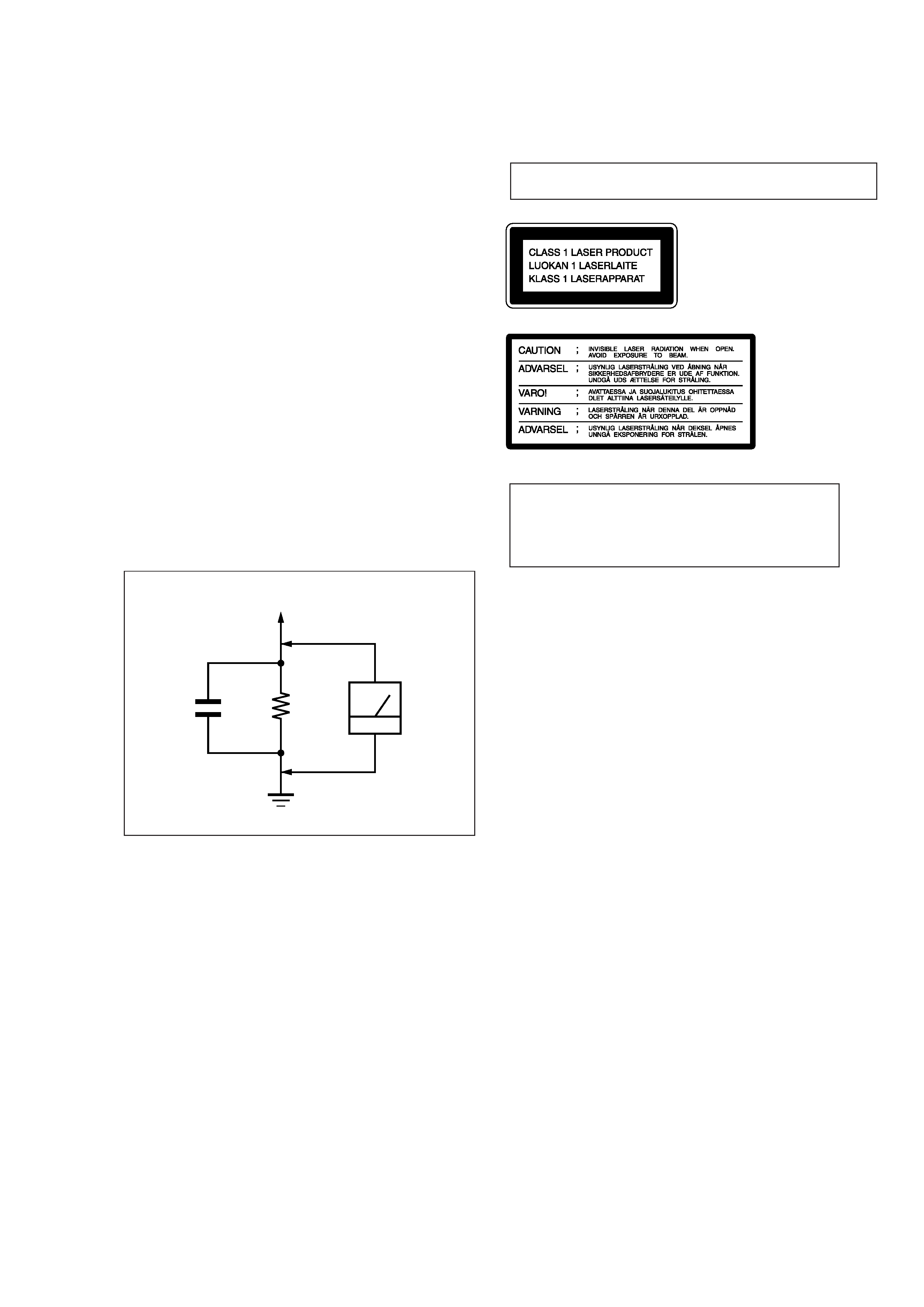
MICROFILM
Model Name Using Similar Mechanism
NEW
CD Mechanism Type
CDM13C-5BD19
Base Unit Name
BU-5BD19
Optical Pick-up Name
KSS-213B/K-N
US Model
Canadian Model
Tourist Model
HCD-T11
E Model
HCD-D11/T11
SERVICE MANUAL
TUNER CD PLAYER
HCD-D11/T11
Photo: HCD-T11
· HCD-D11/T11 is the tuner, CD player and
preamplifier section in CMT-D11/T11.
Continued on next page
Preamplifier section
Frequency response
15 Hz 50 kHz
dB
Inputs
PC/MD IN (US, Canadian model) :
MD IN (Except US, Canadian model) :
Stereo phone jack, sensitivity 450 mV, impedance 47 kilohms
Outputs
DIGITAL OUT (CD OPTICAL OUT) jack:
Digital connector, 18 dBm, wavelength 660 nm
OUTPUT jack:
Stereo phones jack, 1 V, 1 kohm
PC/MD OUT jack (US, Canadian model):
MD OUT jack (Except US, Canadian model):
Stereo phone jack, 250 mV, 1 kohm
PHONES (headphones) jack:
Stereo mini jack, accepts headphones of 8 ohms or more.
General
Power requirents
US, Canadian model
120 V AC, 60 Hz
Except US, Canadian model
120 V or 220 240 V AC, adjustable, 50/60 Hz
Power consumption
25 W (HCD-T11)
20 W (HCD-D11)
+0
3
Tuner section
Tuning range
US, Canadian model:
FM :87.5 108 MHz
AM :531 1,710 kHz (at 9 kHz interval)
530 1,710 kHz (at 10 kHz interval)
Except US, Canadian model:
FM :87.5 108 MHz
AM :531 1,602 kHz (at 9 kHz interval)
530 1,710 kHz (at 10 kHz interval)
Intermediate frequency
FM :10.7 MHz
AM : 450 kHz
Aerial terminals
FM :75 ohm unbalanced
AM :External aerial terminal
Timer
Quarts lock system
Timer setting
One-minute step
Sleep timer 10-minute step, max. 90 minutes
CD player section
System
Compact disc digital audio system
Laser
Semiconductor laser
Wavelength 780 790 nm
Frequency response
2 Hz 20 kHz ± 0.5 dB
Signal to noise ratio
More than 90 dB
Harmonic distortion
Less than 0.03%
SPECIFICATIONS

2
TABLE OF CONTENTS
1.
SERVICE NOTES ....................................................... 4
2.
GENERAL
Index to Parts and Controls ...............................................
5
3.
DISASSEMBLY ............................................................ 7
4.
ELECTRICAL ADJUSTMENTS
Tuner Section ..................................................................... 11
CD Section ......................................................................... 12
5.
DIAGRAMS
5-1. Block Diagram ................................................................... 14
5-2. Printed Wiring Board BD Section ............................... 18
5-3. Schematic Diagram BD Section .................................. 19
5-4. Schematic Diagram Main Section ............................... 22
5-5. Printed Wiring Boards Main Section
(US, Canadian model) ....................................................... 27
5-6. Printed Wiring Boards Main Section
(Except US, Canadian model) ........................................... 32
5-7. IC Pin Function Description .............................................. 38
6.
EXPLODED VIEWS ................................................... 40
7.
ELECTRICAL PARTS LIST .................................... 44
Dimensions Approx. 142
× 125 × 252 mm
(w/h/d) (5 5/8
× 5 × 10 inches)
incl. projecting parts and controls
Mass
Approx. 3 kg (6 lb 10 oz)
Design and specifications are subject to change without notice.
1. Insert the tweezers to a hole on bottom of the
chassis as shown a figure, then tern fully it
toward direction 2.
2. Open the door, pull out the disc table.
1
tweezers
2
4
disc table
cam
3
door
DISC TABLE GETTING OUT PROCEDURE ON THE POWER SUPPLY IS OFF

3
SAFETY CHECK-OUT
After correcting the original service problem, perform the fol-
lowing safety check before releasing the set to the customer:
Check the antenna terminals, metal trim, "metallized" knobs, screws,
and all other exposed metal parts for AC leakage.
Check leakage as described below.
LEAKAGE TEST
The AC leakage from any exposed metal part to earth ground
and from all exposed metal parts to any exposed metal part having a
return to chassis, must not exceed 0.5 mA (500 microampers.). Leak-
age current can be measured by any one of three methods.
1. A commercial leakage tester, such as the Simpson 229 or RCA
WT-540A. Follow the manufacturers' instructions to use these
instruments.
2. A battery-operated AC milliammeter. The Data Precision 245
digital multimeter is suitable for this job.
3. Measuring the voltage drop across a resistor by means of a VOM
or battery-operated AC voltmeter. The "limit" indication is 0.75
V, so analog meters must have an accurate low-voltage scale.
The Simpson 250 and Sanwa SH-63Trd are examples of a pas-
sive VOM that is suitable. Nearly all battery operated digital
multimeters that have a 2 V AC range are suitable. (See Fig. A)
1.5 k
0.15
µF
AC
voltmeter
(0.75 V)
To Exposed Metal
Parts on Set
Earth Ground
Fig. A.
Using an AC voltmeter to check AC leakage.
Laser component in this product is capable of emitting radiation
exceding the limit for Class 1.
This appliance is classified as a
CLASS 1 LASER product.
The CLASS 1 LASER PROD-
UCT MARKING is located on the
rear exterior.
This caution label
is located inside
the unit.
CAUTION
Use of controls or adjustments or performance of
procedures other than those specified herein may
result in hazardous radiation exposure.
SAFETY-RELATED COMPONENT WARNING!!
COMPONENTS IDENTIFIED BY MARK
! OR DOTTED
LINE WITH MARK
! ON THE SCHEMATIC DIAGRAMS
AND IN THE PARTS LIST ARE CRITICAL TO SAFE
OPERATION. REPLACE THESE COMPONENTS WITH
SONY PARTS WHOSE PART NUMBERS APPEAR AS
SHOWN IN THIS MANUAL OR IN SUPPLEMENTS PUB-
LISHED BY SONY.
ATTENTION AU COMPOSANT AYANT RAPPORT
À LA SÉCURITÉ!
LES COMPOSANTS IDENTIFIÉS PAR UNE MARQUE
!
SUR LES DIAGRAMMES SCHÉMATIQUES ET LA LISTE
DES PIÈCES SONT CRITIQUES POUR LA SÉCURITÉ
DE FONCTIONNEMENT. NE REMPLACER CES COM-
POSANTS QUE PAR DES PIÈCES SONY DONT LES
NUMÉROS SONT DONNÉS DANS CE MANUEL OU
DANS LES SUPPLÉMENTS PUBLIÉS PAR SONY.

4
MODEL IDENTIFICATION
Specification Label Printed on Back Panel
MODEL NO.
TUNER CD PLAYER
SERIAL NO.
MADE IN JAPAN
HCD-D11/T11
NOTES ON HANDLING THE OPTICAL PICK-UP
BLOCK OR BASE UNIT
The laser diode in the optical pick-up block may suffer electrostatic
break-down because of the potential difference generated by the
charged electrostatic load, etc. on clothing and the human body.
During repair, pay attention to electrostatic break-down and also
use the procedure in the printed matter which is included in the
repair parts.
The flexible board is easily damaged and should be handled with
care.
NOTES ON LASER DIODE EMISSION CHECK
The laser beam on this model is concentrated so as to be focused on
the disc reflective surface by the objective lens in the optical pick-
up block. Therefore, when checking the laser diode emission, ob-
serve from more than 30 cm away from the objective lens.
Notes on chip component replacement
· Never reuse a disconnected chip component.
· Notice that the minus side of a tantalum capacitor may be dam-
aged by heat.
Flexible Circuit Board Repairing
· Keep the temperature of soldering iron around 270 °C during re-
pairing.
· Do not touch the soldering iron on the same conductor of the
circuit board (within 3 times).
· Be careful not to apply force on the conductor when soldering or
unsoldering.
SECTION 1
SERVICE NOTES
US, Canadian model : AC : 120 V 60 Hz 25 W
Except
US, Canadian model : AC : 120 V/220 240 V
/ 50/60 Hz 20 W (HCD-D11)
: AC : 120 V/220 240 V
/ 50/60 Hz 25 W (HCD-T11)

5
SECTION 2
GENERAL
This section is extracted
from instruction manual.
